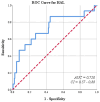Hip axis length and non-hip cortical fragility fractures in young postmenopausal nonobese Caucasian women
- PMID: 40453313
- PMCID: PMC12123106
- DOI: 10.1177/20420188251332082
Hip axis length and non-hip cortical fragility fractures in young postmenopausal nonobese Caucasian women
Abstract
Introduction: Although measuring bone mineral density (BMD) with dual X-ray absorptiometry (DXA) represents the standard of diagnosis and management of osteoporosis, there is a significant number of fragility fractures occurring in young patients without low BMD. Recently, clinical risk tools included hip axis length (HAL), a geometric parameter derived from the hip DXA scan, as a predictor of hip fractures in older postmenopausal women. This study aims to evaluate the relationship between HAL and other cortical bone fractures in young postmenopausal, clinically healthy women.
Materials and methods: This study is a retrospective analysis of Lunar DXA scans of 206 normal or overweight Caucasian women aged 40-60, who had less than 10 years of menopause without secondary causes of osteoporosis, no prior osteoporosis diagnosis or medication, and no history of hip or vertebral fractures.
Results: The 15 fractured women displayed statistically greater HAL values compared to the 191 non-fractured subjects (109.43 ± 6.44 vs 104.81 ± 5.32 mm, p = 0.002), even though there were no significant differences in age, body mass index, or BMD. The difference in HAL remained significant after adjusting for lumbar spine (LS) BMD and height (108.49 ± 1.23 vs 104.88 ± 0.34 mm, p = 0.005). HAL proved to be a fair indicator of non-hip, non-vertebral cortical fractures (area under curve = 0.720, p = 0.003), with a sensitivity of 86.7% and a specificity of 55.5%.
Conclusion: HAL was positively associated with non-hip, non-vertebral cortical bone fragility fractures in young postmenopausal, clinically healthy women and had significantly greater values in the fractured subgroup even after adjusting for LS BMD and height.
Keywords: cortical bone; fragility fractures; hip axis length; osteoporosis; postmenopause.
© The Author(s), 2025.
Conflict of interest statement
The authors declare that there is no conflict of interest.
Figures
Similar articles
-
Utilization of DXA Bone Mineral Densitometry in Ontario: An Evidence-Based Analysis.Ont Health Technol Assess Ser. 2006;6(20):1-180. Epub 2006 Nov 1. Ont Health Technol Assess Ser. 2006. PMID: 23074491 Free PMC article.
-
The Trabecular Bone Score Predicts Spine Fragility Fractures in Postmenopausal Caucasian Women Without Osteoporosis Independently of Bone Mineral Density.Med Arch. 2018 Feb;72(1):46-50. doi: 10.5455/medarh.2018.72.46-50. Med Arch. 2018. PMID: 29416218 Free PMC article.
-
Poverty is a risk factor for osteoporotic fractures.Osteoporos Int. 2009 Mar;20(3):393-8. doi: 10.1007/s00198-008-0697-9. Epub 2008 Sep 5. Osteoporos Int. 2009. PMID: 18773136
-
Assessment of volumetric bone mineral density of the femoral neck in postmenopausal women with and without vertebral fractures using quantitative multi-slice CT.J Zhejiang Univ Sci B. 2009 Jul;10(7):499-504. doi: 10.1631/jzus.B0820409. J Zhejiang Univ Sci B. 2009. PMID: 19585667 Free PMC article.
-
Screening for the primary prevention of fragility fractures among adults aged 40 years and older in primary care: systematic reviews of the effects and acceptability of screening and treatment, and the accuracy of risk prediction tools.Syst Rev. 2023 Mar 21;12(1):51. doi: 10.1186/s13643-023-02181-w. Syst Rev. 2023. PMID: 36945065 Free PMC article.
References
-
- Burge R, Dawson-Hughes B, Solomon DH, et al.. Incidence and economic burden of osteoporosis-related fractures in the United States, 2005–2025. J Bone Miner Res 2007; 22(3): 465–475. - PubMed
-
- Viswanathan M, Reddy S, Berkman N, et al.. Screening to prevent osteoporotic fractures: an evidence review for the U.S. preventive services task force. Rockville (MD): Agency for Healthcare Research and Quality (US), 2018. - PubMed
-
- Johnell O, Kanis JA, Oden A, et al.. Predictive value of BMD for hip and other fractures (published correction appears in J Bone Miner Res 2007; 22(5): 774). J Bone Miner Res 2005; 20(7): 1185–1194. - PubMed
-
- Boschitsch EP, Durchschlag E, Dimai HP. Age-related prevalence of osteoporosis and fragility fractures: real-world data from an Austrian Menopause and Osteoporosis Clinic. Climacteric 2017; 20(2): 157–163. - PubMed
LinkOut - more resources
Full Text Sources



